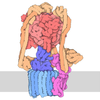[English] 日本語
 Yorodumi
Yorodumi- PDB-8jr0: Cryo-EM structure of Mycobacterium tuberculosis ATP synthase in c... -
+ Open data
Open data
- Basic information
Basic information
| Entry | Database: PDB / ID: 8jr0 | |||||||||||||||||||||
|---|---|---|---|---|---|---|---|---|---|---|---|---|---|---|---|---|---|---|---|---|---|---|
| Title | Cryo-EM structure of Mycobacterium tuberculosis ATP synthase in complex with TBAJ-587 | |||||||||||||||||||||
 Components Components |
| |||||||||||||||||||||
 Keywords Keywords | MEMBRANE PROTEIN / ATP synthase / Mycobacterium tuberculosis / cryo-EM | |||||||||||||||||||||
| Function / homology |  Function and homology information Function and homology informationproton motive force-driven plasma membrane ATP synthesis / proton motive force-driven ATP synthesis / proton-transporting two-sector ATPase complex, proton-transporting domain / proton-transporting ATPase activity, rotational mechanism / H+-transporting two-sector ATPase / proton-transporting ATP synthase complex / proton-transporting ATP synthase activity, rotational mechanism / peptidoglycan-based cell wall / ADP binding / hydrolase activity ...proton motive force-driven plasma membrane ATP synthesis / proton motive force-driven ATP synthesis / proton-transporting two-sector ATPase complex, proton-transporting domain / proton-transporting ATPase activity, rotational mechanism / H+-transporting two-sector ATPase / proton-transporting ATP synthase complex / proton-transporting ATP synthase activity, rotational mechanism / peptidoglycan-based cell wall / ADP binding / hydrolase activity / lipid binding / ATP hydrolysis activity / extracellular region / ATP binding / plasma membrane / cytosol Similarity search - Function | |||||||||||||||||||||
| Biological species |  | |||||||||||||||||||||
| Method | ELECTRON MICROSCOPY / single particle reconstruction / cryo EM / Resolution: 2.8 Å | |||||||||||||||||||||
 Authors Authors | Zhang, Y. / Lai, Y. / Liu, F. / Rao, Z. / Gong, H. | |||||||||||||||||||||
| Funding support |  China, 3items China, 3items
| |||||||||||||||||||||
 Citation Citation |  Journal: Nature / Year: 2024 Journal: Nature / Year: 2024Title: Inhibition of M. tuberculosis and human ATP synthase by BDQ and TBAJ-587. Authors: Yuying Zhang / Yuezheng Lai / Shan Zhou / Ting Ran / Yue Zhang / Ziqing Zhao / Ziyan Feng / Long Yu / Jinxu Xu / Kun Shi / Jianyun Wang / Yu Pang / Liang Li / Hongming Chen / Luke W Guddat / ...Authors: Yuying Zhang / Yuezheng Lai / Shan Zhou / Ting Ran / Yue Zhang / Ziqing Zhao / Ziyan Feng / Long Yu / Jinxu Xu / Kun Shi / Jianyun Wang / Yu Pang / Liang Li / Hongming Chen / Luke W Guddat / Yan Gao / Fengjiang Liu / Zihe Rao / Hongri Gong /   Abstract: Bedaquiline (BDQ), a first-in-class diarylquinoline anti-tuberculosis drug, and its analogue, TBAJ-587, prevent the growth and proliferation of Mycobacterium tuberculosis by inhibiting ATP synthase. ...Bedaquiline (BDQ), a first-in-class diarylquinoline anti-tuberculosis drug, and its analogue, TBAJ-587, prevent the growth and proliferation of Mycobacterium tuberculosis by inhibiting ATP synthase. However, BDQ also inhibits human ATP synthase. At present, how these compounds interact with either M. tuberculosis ATP synthase or human ATP synthase is unclear. Here we present cryogenic electron microscopy structures of M. tuberculosis ATP synthase with and without BDQ and TBAJ-587 bound, and human ATP synthase bound to BDQ. The two inhibitors interact with subunit a and the c-ring at the leading site, c-only sites and lagging site in M. tuberculosis ATP synthase, showing that BDQ and TBAJ-587 have similar modes of action. The quinolinyl and dimethylamino units of the compounds make extensive contacts with the protein. The structure of human ATP synthase in complex with BDQ reveals that the BDQ-binding site is similar to that observed for the leading site in M. tuberculosis ATP synthase, and that the quinolinyl unit also interacts extensively with the human enzyme. This study will improve researchers' understanding of the similarities and differences between human ATP synthase and M. tuberculosis ATP synthase in terms of the mode of BDQ binding, and will allow the rational design of novel diarylquinolines as anti-tuberculosis drugs. | |||||||||||||||||||||
| History |
|
- Structure visualization
Structure visualization
| Structure viewer | Molecule:  Molmil Molmil Jmol/JSmol Jmol/JSmol |
|---|
- Downloads & links
Downloads & links
- Download
Download
| PDBx/mmCIF format |  8jr0.cif.gz 8jr0.cif.gz | 811.4 KB | Display |  PDBx/mmCIF format PDBx/mmCIF format |
|---|---|---|---|---|
| PDB format |  pdb8jr0.ent.gz pdb8jr0.ent.gz | 672.3 KB | Display |  PDB format PDB format |
| PDBx/mmJSON format |  8jr0.json.gz 8jr0.json.gz | Tree view |  PDBx/mmJSON format PDBx/mmJSON format | |
| Others |  Other downloads Other downloads |
-Validation report
| Summary document |  8jr0_validation.pdf.gz 8jr0_validation.pdf.gz | 1.7 MB | Display |  wwPDB validaton report wwPDB validaton report |
|---|---|---|---|---|
| Full document |  8jr0_full_validation.pdf.gz 8jr0_full_validation.pdf.gz | 1.8 MB | Display | |
| Data in XML |  8jr0_validation.xml.gz 8jr0_validation.xml.gz | 127.8 KB | Display | |
| Data in CIF |  8jr0_validation.cif.gz 8jr0_validation.cif.gz | 195.3 KB | Display | |
| Arichive directory |  https://data.pdbj.org/pub/pdb/validation_reports/jr/8jr0 https://data.pdbj.org/pub/pdb/validation_reports/jr/8jr0 ftp://data.pdbj.org/pub/pdb/validation_reports/jr/8jr0 ftp://data.pdbj.org/pub/pdb/validation_reports/jr/8jr0 | HTTPS FTP |
-Related structure data
| Related structure data |  36589MC 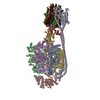 8j0sC 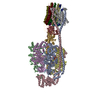 8j0tC 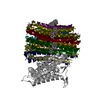 8j57C  8j58C  8jr1C  8khfC  8ki3C M: map data used to model this data C: citing same article ( |
|---|---|
| Similar structure data | Similarity search - Function & homology  F&H Search F&H Search |
- Links
Links
- Assembly
Assembly
| Deposited unit | 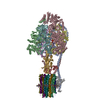
|
|---|---|
| 1 |
|
- Components
Components
-ATP synthase ... , 7 types, 19 molecules ABCDEFGH123456789ab
| #1: Protein | Mass: 59358.070 Da / Num. of mol.: 3 Source method: isolated from a genetically manipulated source Source: (gene. exp.)   Mycolicibacterium smegmatis (bacteria) Mycolicibacterium smegmatis (bacteria)References: UniProt: P9WPU7, H+-transporting two-sector ATPase #2: Protein | Mass: 53150.934 Da / Num. of mol.: 3 Source method: isolated from a genetically manipulated source Source: (gene. exp.)   Mycolicibacterium smegmatis (bacteria) Mycolicibacterium smegmatis (bacteria)References: UniProt: P9WPU5, H+-transporting two-sector ATPase #3: Protein | | Mass: 33929.332 Da / Num. of mol.: 1 Source method: isolated from a genetically manipulated source Source: (gene. exp.)   Mycolicibacterium smegmatis (bacteria) / References: UniProt: P9WPU9 Mycolicibacterium smegmatis (bacteria) / References: UniProt: P9WPU9#4: Protein | | Mass: 13149.744 Da / Num. of mol.: 1 Source method: isolated from a genetically manipulated source Source: (gene. exp.)   Mycolicibacterium smegmatis (bacteria) / References: UniProt: P9WPV1 Mycolicibacterium smegmatis (bacteria) / References: UniProt: P9WPV1#5: Protein | Mass: 8058.423 Da / Num. of mol.: 9 Source method: isolated from a genetically manipulated source Source: (gene. exp.)   Mycolicibacterium smegmatis (bacteria) / References: UniProt: A0A045H4W8 Mycolicibacterium smegmatis (bacteria) / References: UniProt: A0A045H4W8#6: Protein | | Mass: 27488.436 Da / Num. of mol.: 1 Source method: isolated from a genetically manipulated source Source: (gene. exp.)  Gene: atpB, ERS007657_00358, ERS007661_00092, ERS007663_00105, ERS007665_00910, ERS007670_00031, ERS007679_03316, ERS007681_03471, ERS007688_02939, ERS007703_00159, ERS007720_03212, ERS007722_00190, ...Gene: atpB, ERS007657_00358, ERS007661_00092, ERS007663_00105, ERS007665_00910, ERS007670_00031, ERS007679_03316, ERS007681_03471, ERS007688_02939, ERS007703_00159, ERS007720_03212, ERS007722_00190, ERS007739_02359, ERS007741_03568, ERS024276_02583, ERS027646_02991, ERS027659_00329, ERS027661_00021, SAMEA2683035_01568 Production host:  Mycolicibacterium smegmatis (bacteria) / References: UniProt: A0A045J1C5 Mycolicibacterium smegmatis (bacteria) / References: UniProt: A0A045J1C5#7: Protein | | Mass: 18345.771 Da / Num. of mol.: 1 Source method: isolated from a genetically manipulated source Source: (gene. exp.)   Mycolicibacterium smegmatis (bacteria) / References: UniProt: A0A045H294 Mycolicibacterium smegmatis (bacteria) / References: UniProt: A0A045H294 |
|---|
-Protein , 1 types, 1 molecules d
| #8: Protein | Mass: 48866.648 Da / Num. of mol.: 1 Source method: isolated from a genetically manipulated source Source: (gene. exp.)   Mycolicibacterium smegmatis (bacteria) / References: UniProt: A0A045JVE3 Mycolicibacterium smegmatis (bacteria) / References: UniProt: A0A045JVE3 |
|---|
-Non-polymers , 4 types, 17 molecules 




| #9: Chemical | | #10: Chemical | ChemComp-MG / #11: Chemical | #12: Chemical | ChemComp-UTI / ( Mass: 614.503 Da / Num. of mol.: 7 / Source method: obtained synthetically / Formula: C30H33BrFN3O5 |
|---|
-Details
| Has ligand of interest | N |
|---|---|
| Has protein modification | N |
-Experimental details
-Experiment
| Experiment | Method: ELECTRON MICROSCOPY |
|---|---|
| EM experiment | Aggregation state: PARTICLE / 3D reconstruction method: single particle reconstruction |
- Sample preparation
Sample preparation
| Component | Name: Mycobacterium tuberculosis ATP synthase / Type: COMPLEX / Entity ID: #1-#4 / Source: RECOMBINANT |
|---|---|
| Source (natural) | Organism:  |
| Source (recombinant) | Organism:  Mycolicibacterium smegmatis (bacteria) Mycolicibacterium smegmatis (bacteria) |
| Buffer solution | pH: 7.4 |
| Specimen | Embedding applied: NO / Shadowing applied: NO / Staining applied: NO / Vitrification applied: YES |
| Vitrification | Cryogen name: ETHANE |
- Electron microscopy imaging
Electron microscopy imaging
| Experimental equipment |  Model: Titan Krios / Image courtesy: FEI Company |
|---|---|
| Microscopy | Model: FEI TITAN KRIOS |
| Electron gun | Electron source:  FIELD EMISSION GUN / Accelerating voltage: 300 kV / Illumination mode: FLOOD BEAM FIELD EMISSION GUN / Accelerating voltage: 300 kV / Illumination mode: FLOOD BEAM |
| Electron lens | Mode: BRIGHT FIELD / Nominal defocus max: 2400 nm / Nominal defocus min: 1200 nm |
| Image recording | Electron dose: 50 e/Å2 / Film or detector model: FEI FALCON IV (4k x 4k) |
- Processing
Processing
| EM software | Name: PHENIX / Category: model refinement | ||||||||||||||||||||||||
|---|---|---|---|---|---|---|---|---|---|---|---|---|---|---|---|---|---|---|---|---|---|---|---|---|---|
| CTF correction | Type: PHASE FLIPPING AND AMPLITUDE CORRECTION | ||||||||||||||||||||||||
| 3D reconstruction | Resolution: 2.8 Å / Resolution method: FSC 0.143 CUT-OFF / Num. of particles: 81528 / Symmetry type: POINT | ||||||||||||||||||||||||
| Refine LS restraints |
|
 Movie
Movie Controller
Controller

















 PDBj
PDBj
